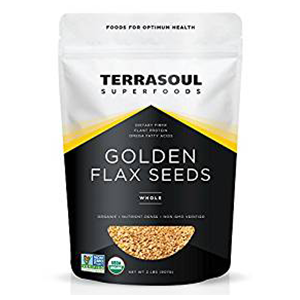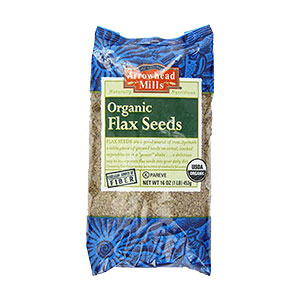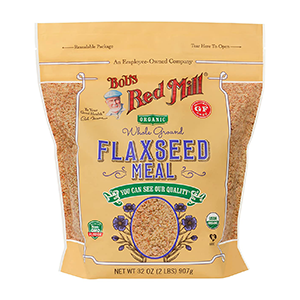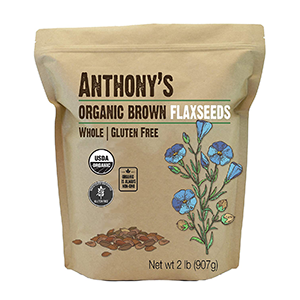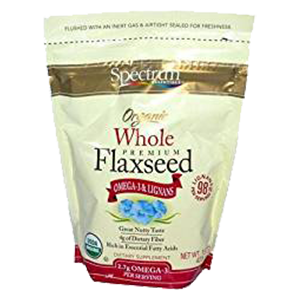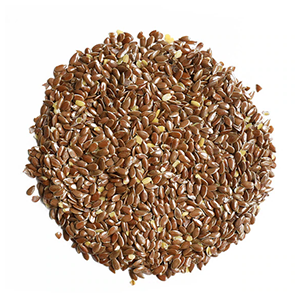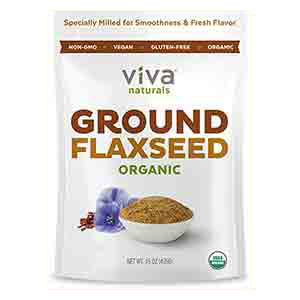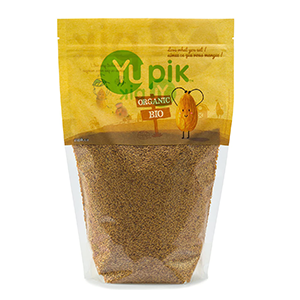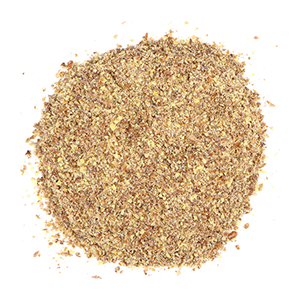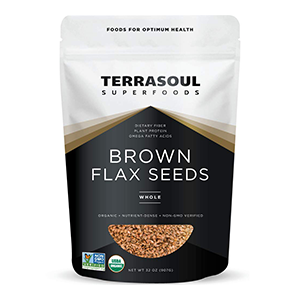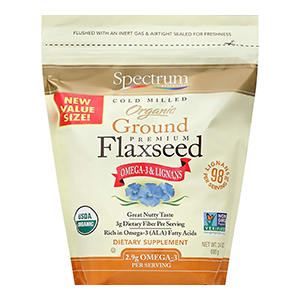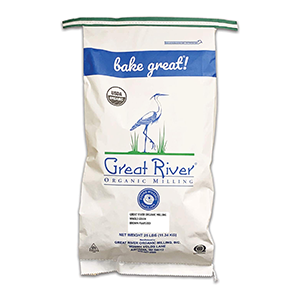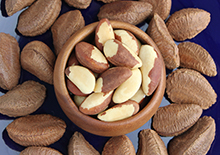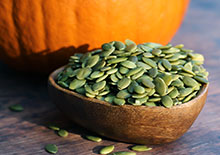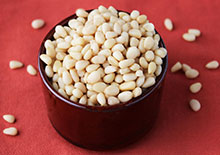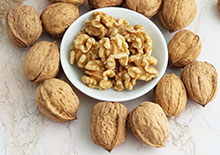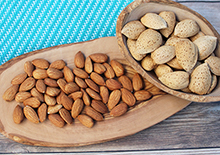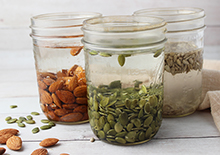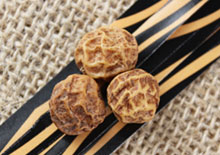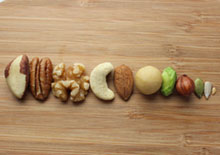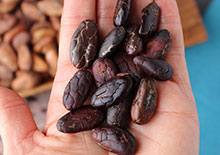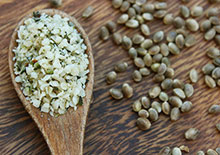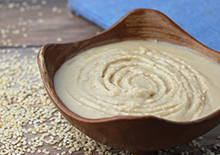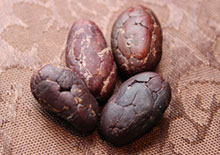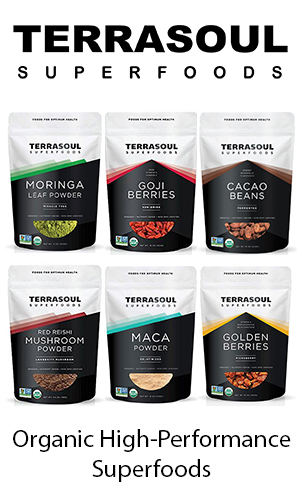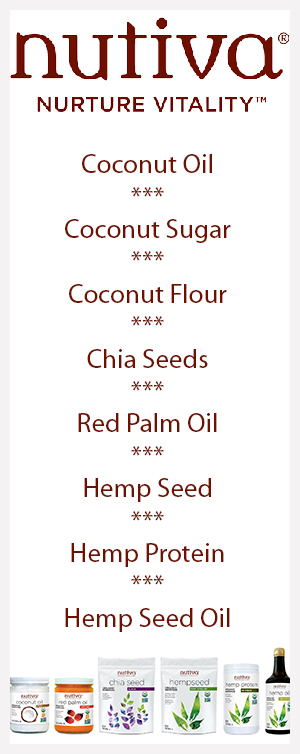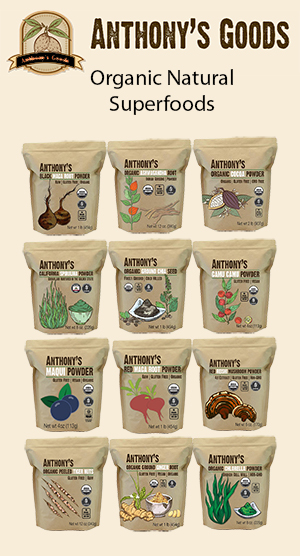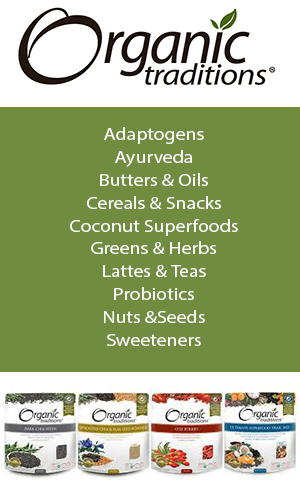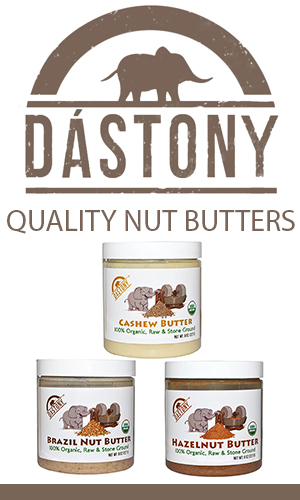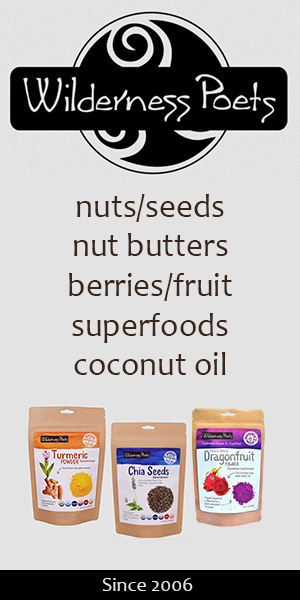- Home
- Nuts and Seeds
- Flaxseeds
Health Benefits of Flaxseeds, An Omega-3 High Fiber Food
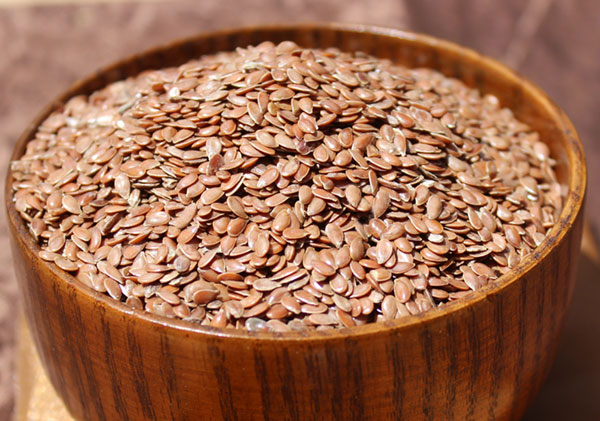
Flaxseeds come from one of the world's first cultivated plant species recognized on the list of eight "Neolithic founder crops" of early agriculture. Domesticated from wild flax by ancient farming communities in the Fertile Crescent region of the Middle East, the plant was extensively utilized for its versatility as both a fiber and oilseed crop.
The seeds are now also nutritionally valued as a nourishing dietary superfood due to their particularly high amount of omega-3's, fiber and lignan content, ranking #1 in all three categories for any vegan food source.
The small glossy coated seeds are in fact most commonly known for their extracted flax oil content. Being a plant-based form of the omega-3 fatty acid ALA, flax oil supplements were one of the first omega oils popularized by Western health enthusiasts in the 70's and 80's and have been widely endorsed as a nutritional supplement since this time.
The seeds are also viewed as extremely nutritive because of their unique concentrated dietary fiber profile, acting as a natural gentle laxative that simultaneously helps to sooth intestinal inflammation and related conditions.
Composed of approximately 32% fiber and 3% carbs per three tablespoon serving size, they make an ideal low calorie yet appetite-satisfying addition to drinks, meals or recipes.
Considered a colon friendly food, the seeds of flax are one of the few nut and seed varieties recommended for those with candida overgrowth as they act as a prebiotic to healthy gut flora, are balancing to body pH and promote bowel regularity. They are thus one of the few protein-fat sources permitted on the Body Ecology Diet. (*)
Ground or soaked and blended seeds are also a rich source of polyphenols called lignans, a potent antioxidant and antibacterial compound. Often recommended as a dietary supplement for women experiencing menopause, lignans are also considered a phytoestrogen, which can subsequently mimic estrogen hormones depending on dose amount and other factors unique to each individual.
The whole seeds should never be consumed straight by the handful, but are either soaked and further blended or likewise ground as a type of flour, frequently referred to as "flax meal". It is important to drink plenty of liquids when consuming ground flax otherwise dehydration may occur.
Flax is a common ingredient in green powders, protein powder blends and natural laxative formulas. It is also often sold as a meal mixed with ground chia seeds, which have very similar properties.
The bulk seeds are relatively inexpensive, compared to other nut and seed types. We always advise purchasing seeds from organic non-GMO brands as flax is one of the most heavily sprayed as well as genetically modified conventionally grown food crops.
Best When Consumed Raw and Unheated
Although the seeds are sometimes roasted to increase flavor as well as incorporated as a "health food" ingredient in commercial breads, cereals, muffins and breakfast bars, they are the most nutritious when consumed in their raw unheated state.
Heating or baking with flax meal, seeds or oils over 120 F° (49 C°) destroys most of their nutrient content, especially the polyunsaturated fats or short chain omega-3 fatty acids that will easily oxidize when exposed to heat or light.
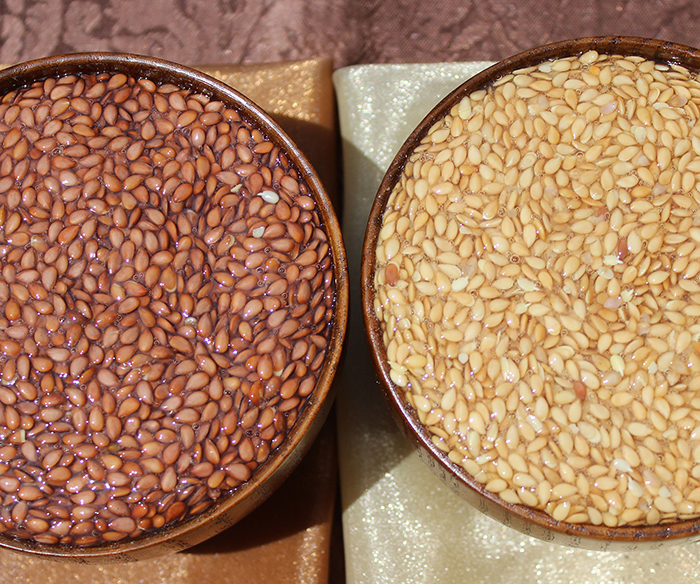
What are Flaxseeds?
Check out our page on the main differences between Chia Vs Flax.
Flaxseeds, also spelled as two words: "flax seed", come from the domesticated species Linum usitatissimum or the common linseed plant. The Latin name "usitatissimum", meaning "most useful", appropriately describes its versatility as a textile, oilseed crop as well as a food source.
These characteristics are very similar to the hemp plant, also agriculturally valued for its variety of uses. The stems of the linseed plant are likewise composed of strong fibers which are used to make the fabric known as "linen."
The seed extracted linseed oil has been utilized for centuries in paints, varnishes and other wood finishing products, as well as printing ink and linoleum.
Usually the term "linseed" refers to these industrial uses and the term "flax" is typically associated with its use as a food and edible oil source. (*)
Believed to have originated from the wild species Linum bienne, called pale flax, which is native to the Mediterranean and regions of India and western Europe. This wild variety has now naturalized to other countries and climate zones, such as British Columbia and the U.S. states of Oregon, California and Pennsylvania. (*)
Wild flax, according to archeological evidence (*), was domesticated more than 8,000 years ago in the region located around Mesopotamia referred to as the "Fertile Crescent", also known as the "cradle of civilization."
The popular cultivated subspecies Linum usitatissimum is today adaptable to many different growing conditions and locations worldwide.
While there are other similar species found in the genus Linum, this is the most commonly produced variety. It is an annual plant that grows close to between 3-4 feet tall (.91-1.21 meters) with slender stems and pale periwinkle blue flowers. The small glossy seeds, a similar shape to an apple seed, come from the round dry fruit capsule produced at the end of the season.
Domesticated flaxseed comes in two basic varieties: brown or golden and are generally considered to possess the same nutritional properties.
Canada is one of the major flaxseed and linseed oil producers worldwide, followed by other countries including Kazakhstan, China, Russia, the United States and India.
Health Benefits of Flaxseeds
Gelatinous Fiber Source, Good for Bowel Regularity
Flaxseeds are high in mucilage, a type of polysaccharide and form of soluble dietary fiber.
This mucilage content becomes particularly evident when the seeds are soaked in water or any kind of liquid. They essentially thicken into a goopy gelatinous substance after only a few minutes, swelling about 6-8 times their original size.
The soaked or ground seeds, as we previously mentioned, are not normally consumed directly, but can be blended or processed into drinks or recipes.
Containing both insoluble and soluble dietary fiber, flaxseeds usually average in at about a 2:1 or 3:1 ratio respectively, with some reports indicating varied proportions "between 20:80 and 40:60" insoluble to soluble fiber content. (*)
The soluble seed fiber is readily fermented in the colon, where it acts as a prebiotic to intestinal microbiota, and normally delays gastric emptying into the small intestine. This characteristic is believed to improve absorption of certain nutrients and helps to suppress the appetite, extending one's feeling of fullness.
The thick mucilage gel is also beneficial for reducing intestinal inflammation as well as providing for bowel regularity, offering cleansing actions as a natural laxative, similar to chia, aloe and psyllium.
The insoluble fiber in flax, consisting of cellulose and lignin, is not dissolved by water but instead absorbs it as it passes through the GI tract. It is known for its bulking actions that help to move undigested waste material and ease defecation.
Flaxseeds, and their soothing qualities, are often used as a dietary fiber supplement for those with intestinal disorders, particularly helpful for constipation, IBS and conditions like diverticulitis.
In the Journal of Food Science and Technology it was reported that "Water-binding capacity of flaxseed insoluble fiber increases the intestinal bulk which is useful in the treatment of constipation, irritable bowel syndrome and diverticular disease." (Source)
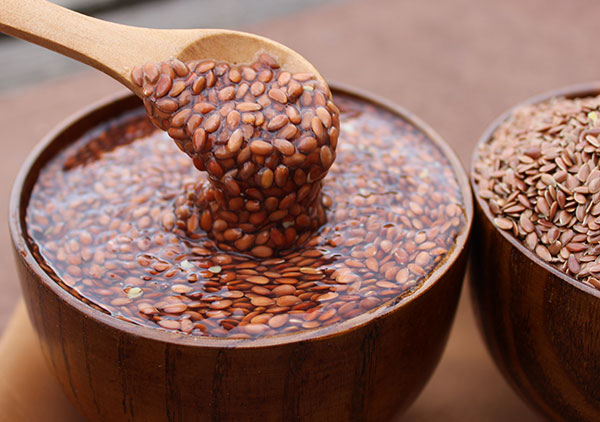
For this reason, flax is commonly offered in supplement form by holistic practitioners for such conditions.
However, it is important to remember that large quantities of flaxseed consumed with inadequate amounts of water can have a tendency to promote intestinal discomfort, bloating and flatulence, which may potentially exacerbate certain issues.
A daily dose of 1-2 tablespoons of ground flaxseeds should therefore be taken with a good amount of fluids or mixed into water to avoid these side-effects. For therapeutic actions as a natural laxative, we recommend 2-3T soaked flax seeds or flax meal blended into water, smoothies or shakes.
On the USDA’s National Nutritional Database, it is reported that 1T of
raw flax seeds contains 2.8g of dietary fiber which meets 11% of the
RDA for adults, based on a 2,000 calorie diet.
Flaxseeds, Top Plant-Based Source of ALA Omega-3
Approximately two-thirds of the total fat content in glossy-looking flaxseeds is in
the form of polyunsaturated fats or the omega fatty acids: omega-3, omega-6 and
omega-9.
Like chia and hemp seeds, they are particularly high in the short chain omega-3 fatty acid known as ALA or alpha-linolenic acid.
Both the omega-3 fatty acids, ALA and EPA, act as an anti-inflammatory aid and help to counteract the pro-inflammatory effects of LA omega-6 fats and their derived oils.
A healthy diet should consist of a proper proportion of omega-6 to omega-3's. The general standard for this is between a 4:1 or 1:1 ratio. This means that for the amount of omega-6 foods you consume you would need to eat at least 1/4 of that amount in the form of omega-3's.
Omega-6's are especially concentrated in refined vegetable oils such as corn oil, cottonseed oil, sunflower oil, safflower oil, peanut oil and sesame oil. They are also concentrated in grain-fed meat protein and dairy products. These sources are high in omega-6 because the animal eats the LA-rich livestock feed which gets concentrated in the flesh, fat and milk. This is one of the main reasons why grass-fed animal foods are considered more nutritious than conventionally raised domesticated animals.
With the typical Western diet, high in refined vegetable oils, meat and dairy, omega-6 is much higher than omega-3 at an average 10:1 to 20:1 ratio. Too much omega-6 can cause inflammation in the body and other related health conditions.
Flaxseed Ratios of Omega-6 to Omega-3
According to Nutrition Data, both whole and ground flax contain close to a 1:4 ratio of omega-6 to omega-3, which is very rare for most nuts and seeds. (*)
1T Whole Flaxseeds (10g) - 2.9g total polyunsaturated fat
606mg omega-6
2338mg omega-3
1T Ground Flaxseeds (7g) - 2.0g total polyunsaturated fat
414mg omega-6
1597mg omega-3
Soaked and blended whole flax or ground seeds therefore make an especially good ALA supplement to add to the diet for balancing this ratio. The general recommendation for a healthy adult consuming a more balanced ratio of omega-6 to omega-3 is 2g or 2000mg of ALA a day, roughly the equivalent of 1T. For others, this amount would often be much higher, like between 2-3T daily.
The omega-3's, ALA, EPA and DHA, are essential healthy fats to routinely include in the diet over the course of one's lifetime. DHA is extremely pertinent for maintaining proper neurological and brain functions, hormone regulation, and essential for pregnant or breastfeeding women.
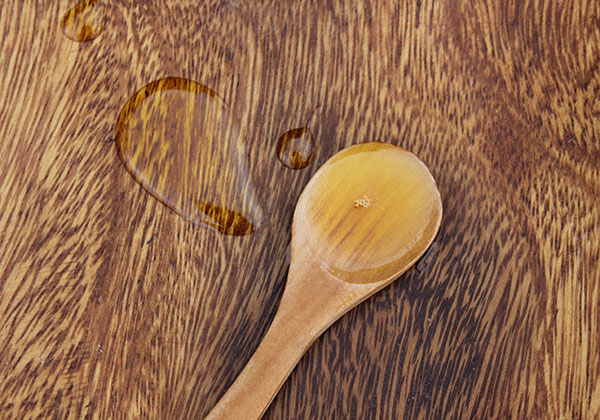
Does the ALA in Flaxseeds Convert to EPA and DHA in the Body?
While cold water fish or its extracted oils are undeniably a great source of the long-chain omega-3 fats, EPA and DHA, plant-based ALA-rich foods like flax are claimed by some health experts to convert into both EPA and DHA.
This is a largely debated issue however, because it varies from person to person. EPA, being closer in molecular form to ALA, is more effectively transformed from ALA-rich foods than DHA.
Evidently the conversion of ALA to DHA is most efficiently achieved when there is already a balance of omega-6 to omega-3 in the diet. Most studies test subjects well out of the balanced ratio, consequently demonstrating that we can ONLY get EPA and DHA from marine food sources.
However, according to some reports published in the 2014 Journal of Food Science and Technology, "ALA can be metabolized in the body into docosahexaenoic acid (DHA) (ω-3) and eicosapentaenoic acid (EPA) (ω-3)." (*)
In in the same review it was also stated that "The health benefits of all ω-3 fatty acids (ALA, EPA and DHA) have been widely reported for several conditions including cardiovascular disease, hypertension, atherosclerosis, diabetes, cancer, arthritis, osteoporosis, autoimmune and neurological disorders."
Flax Oil Supplements
The oil from flax has been used for decades as one of the richest sources of omega-3 ALA. One tablespoon of organic Barlean's Flax Oil brand, contains 7230mg omega-3 and 1800mg omega-6 fatty acids, coming in at a 4:1 ratio, the highest and most balanced of any plant-based oil source.
Because of the volatile nature of polyunsaturated fats, quality unrefined flax oils are carefully cold-pressed from fresh organic seeds and bottled in dark containers to protect the oil from light and oxidation. Some brands, like Jarrow Formulas, add small amounts of other ingredients to make it more stable and less likely to go rancid.
While oil supplements concentrate these omega-3 nutrients, they are not a high source of fiber or lignan content, properties that are retained only in the whole or ground seed. Some brands like Barlean's add small particles of the seed to add back in these nutrients.
Flax oil supplements are available as straight oil's, but are additionally found in capsule form because of their stronger taste.
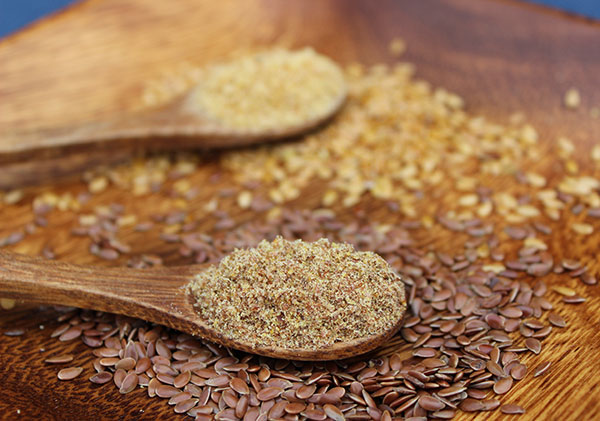
Contains Antioxidant-Rich Polyphenols Called Lignans
One of the most advertised benefits of the flax seed, next to its omega-3 oil content, is its high amount of lignan precursors. These are fiber-related polyphenol compounds that are also found in a wide variety of whole foods and superfoods.
Flaxseeds, however, are by far the richest source of lignans among any other dietary selection.
According to the Linus Pauling Institute, one ounce of seed is equivalent to 85.5mg of lignan content, with sesame seed being the second highest dietary source at 11.2mg. (*)
Lignans are substances that not only act as antioxidants to prevent free radical damage, but can also effect estrogen hormones, depending on dose amount and other factors.
Lignan precursors when consumed get converted by intestinal bacteria into the enterolignans called enterodiol and enterolactone. These are categorized as phytoestrogens, non-steroidal chemicals with a similar structure to estrogen, which can either mimic the effects of estrogenic hormones or block their influence.
In a Cornell University program studying phytoestrogens they were described accordingly: "Working as estrogen mimics, phytoestrogens may either have the same effects as estrogen or block estrogen’s effects. Which effect the phytoestrogen produces can depend on the dose of the phytoestrogen. The phytoestrogen can act like estrogen at low doses but block estrogen at high doses." (Source)
In other reported research, one of the primary lignan precursors found in flaxseed, secoisolariciresinol diglucoside, was shown to increase both enterodiol and enterolactone up to 40% after a single dose intake and believed to be an indication of "dietary lignan exposure."
While we wouldn't generally recommend flaxseed to those with hypothyroidism or estrogen-related tumor growth, in higher dose amounts it can potentially act as an aromatase inhibitor or estrogen antagonist by sitting in and blocking receptor sites against estrogen.
Although the study of how phytoestrogens affect human hormone levels has proven to be a complex issue that is not yet thoroughly understood, some research indicates that phytoestrogens can have varied effects from one individual to the next. This is thought to be dependent on a number of factors such as overall health, balance of intestinal microbiota, body type, unique hormone levels, amount of daily activity as well as current diet and lifestyle practices.
Before regularly consuming phytoestrogen-rich food, like flaxseeds in the diet it therefore may be helpful to seek the advice of a nutritionist or qualified healthcare practitioner who can specifically analyze your particular needs and health issues.
Remember that pure flax oil, which is commonly sold as a dietary supplement, does not contain lignan compounds and can therefore provide omega-3 benefits to those trying to reduce phytoestrogens from the diet.
Flaxseeds Potential Use for Menopausal Symptoms
Flaxseeds are often credited with the ability to reduce hot flash symptoms in menopausal women chiefly due to their potential capacity to increase estrogen. This, however, has not been demonstrated true for all women.
While menopausal women may find the other benefits of flaxseed nutrition useful, specifically the omega-3 oil and dietary fiber content, presently there are mixed findings on the regular use of flaxseeds for decreasing hot flash episodes.
A study published in the 2012 edition of the journal Menopause concluded that "The results of this trial do not support the use of 410 mg of lignans for the reduction of hot flashes."
Conversely in 2015, other research showed that "menopausal symptoms decreased and the quality of life increased among the women who used flaxseed for 3 months." (*)
In a 2016 review entitled Use of Plant-Based Therapies and Menopausal Symptoms, it was also concluded that the "Use of phytoestrogens was associated with a decrease in the number of daily hot flashes and vaginal dryness score between the treatment groups but not in the number of night sweats." (Source)
Generally, the recommended dose amount for peri or post-menopausal women is about 2T of ground flax per day, consumed with plenty of water.
Again, flax seed's ability to effect estrogen is dependent on many different factors. We would personally place healthy gut flora at the top of this list, since beneficial bacteria are essential for the hormonal conversion process.

A Heart Healthy Nutritional Supplement
There are numerous studies in the last decade observing how flaxseeds added to one's daily diet can have a positive effect on heart health, reducing cardiovascular disease risk factors by lowering LDL cholesterol levels and helping to prevent atherosclerosis.
The viscous soluble fiber content found in flax has shown to be particularly beneficial for its ability to influence bile acid metabolism, which subsequently helps to use up excess cholesterol, and according to research published in the Journal of Nutrition and Metabolism, "significantly increased fat excretion and lowered total and LDL-cholesterol" (Source)
Flaxseeds Benefits to the Skin and Hair
Adding 2T of soaked flax seeds, along with 1T of flax oil, to a daily morning smoothie is a great way to help nourish the skin and hair.
The soluble mucilage polysaccharides in flax and the omega's found in the seed extracted oils are very beneficial to the skin when consumed internally, helping to moisturize and lubricate the body from the inside out.
They are also excellent nutrition for healthy hair and, according to Ayurveda, are useful for increasing "balya" providing elasticity and tensile strength. Flax is particularly good for Vata imbalances where constipation and general dryness are usually an issue. (*)
Other Top Flaxseed Nutrients
Two tablespoons of ground flax contain the following Recommended Daily Allowance (RDA) based on a 2,000 calorie diet.
- Protein - 6% RDA (2.6g)
- Thiamine - 16% RDA
- Magnesium - 14% RDA
- Manganese - 18% RDA
- Copper - 8% RDA
- Phosphorus - 8% RDA
- Selenium - 6% RDA
Flax seed contains trace amounts of 2% or less of vitamin B6, folate, pantothenic acid, calcium, iron, potassium and zinc.
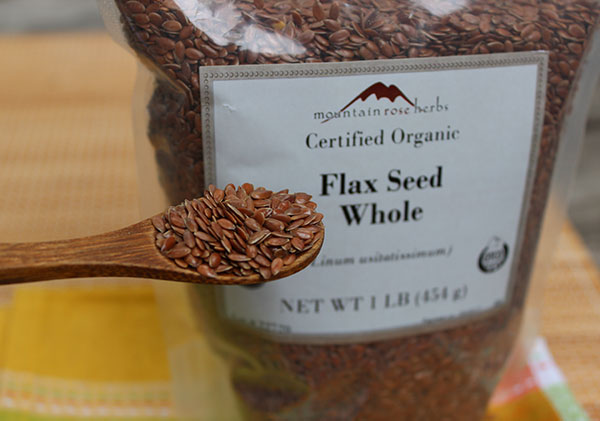 (Mountain Rose Herbs is a paid sponsor of this website. The opinions expressed here, however, are completely our own.)
(Mountain Rose Herbs is a paid sponsor of this website. The opinions expressed here, however, are completely our own.)Favorite Top Organic Flaxseed Suppliers
Flaxseeds are one of those food crops susceptible to genetic modification, so it is good to purchase non-GMO verified and organically certified seeds whenever possible.
Quality seeds remain viable and will sprout or can be planted to garden grow a flax plant. Sprouting the seeds is a good way to test for nutritional quality.
- Spectrum Essentials - Organic Whole Brown and Golden Seeds, Powder
- Sunfood - Organic Golden Flax Seeds
- Mountain Rose Herbs - Organic Whole Brown Flax Seed and Meal
- Viva Naturals - Organic Ground Flax Seed, Cold-Milled
- Arrowhead Mills - Brown and Golden Flax Seed
- Terrasoul Superfoods - Organic Golden Flax Seeds
- Bob's Red Mill - Organic Whole Brown and Golden Flaxseed
How to Use
When introducing ground or soaked flax into the diet, it is best to start with small doses and work your way up to one or two tablespoons daily.
The #1 rule when consuming flax is to drink plenty of water or soak them before use to prevent dehydration.
The flax seed is similar to chia and psyllium in its ability to absorb
water and form a gelatinous consistency when soaked for a short period
of time. Whole pre-soaked seeds can be incorporated into blended or food processed recipes.
As we mentioned, it is important to never heat or roast flax seeds as this will destroy their nutrients and especially the highly volatile polyunsaturated fats.
To Soak Flaxseeds:
Place 3T of flax into a half pint mason jar and fill with 3/4C of water, stir and let sit for 20-30 minutes. The seedy gel can be stored in fridge with a lid and will last several days or even over a week in most cases.
Soaked flax can be used like chia seeds to naturally thicken many foods, drinks, dips and desserts. Our top favorite way to use soaked flax is high speed blended into smoothies.
Ground flax is often used like a condiment, sprinkled onto meals, breakfast cereals, raw soups or salads.
Raw
vegan chefs also commonly use the whole soaked seeds to make flaxseed
crackers. Flax meal is likewise utilized as binding ingredient when making dehydrated flourless breads, granola, croutons and
raw cookies.
You should never try to eat whole flaxseeds by the
handful. Even when soaked and dehydrated as a cracker, you still must
chew them well.
As a dietary supplement, it can also be simply mixed into water, allowed to sit for a few minutes and consumed. Flaxseed has a mild nutty flavor, but can also have a strong "fishy" taste depending on one's palate. Sometimes capsules make a good alternative for those who don't prefer the taste of the seeds or oil.
Making Your Own Flax Meal
Whole flaxseeds are far more stable than pre-milled flax which has a minimum shelf life when stored at room temperature and can go rancid quickly.
In our opinion, it is best to use freshly ground flaxseed for highest nutritive value. This is easily done by placing the whole seeds in a high speed
blending device or coffee/spice grinder and grinding
them until a loose mealy powder is achieved. Whole seeds will increase in volume when ground, so 1C of flaxseed will become 1 1/2C flax meal, which can be stored in an air tight container in the fridge or freezer.
The
next best option would be to purchase
flax meal, but make sure to keep it in the fridge to prevent it from going rancid.
You can often purchase flaxseed meal or powder that is cold milled to
preserve nutritional quality.
Flax sprouting is not as common as other growing other sprout types, but it can be achieved microgreen style, like sunflower sprouts, or by mat sprouting.
Precautions:
Excessive consumption of flaxseeds with inadequate amounts of water may cause constipation as well as intestinal discomfort, which may aggravate certain gastrointestinal disorders. Seek the advice of your healthcare provider if you are diagnosed with a thyroid condition, have serious health issues or are taking prescribed medications.
Shop Related Products (About Affiliates & Amazon Associate Paid Links)
Affiliate Disclaimer: This section contains affiliate product links. If you make a purchase through one of our recommended links, we will receive a small commission at no additional cost to you. Thanks for the support!
